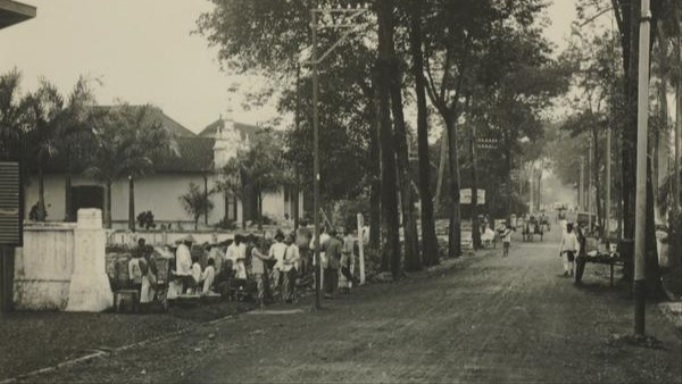Scattered Nazi Traces in Bandung
Hitler decided to send U-Boat submarines to the Java Sea to aid its ally, the Japanese, to fight the Dutch. Ended up helping Indonesia’s struggle for independence.
Penulis Alda Agustine Budiono 11 Oktober 2023
BandungBergerak.id – In 2011, Henry Mulyana decided to open an unusual cafe called The Soldatenkaffe, or The Army Cafe. Its wall displayed World War II attributes, especially the ones connected to Nazi. Visitors could eat under swastika banners as well as see memorabilia such as gas masks and German soldier uniforms. Unfortunately, this cafe wasn’t interesting enough for Bandung people, since not many of them are familiar with World War II history, especially the Holocaust. Moreover, this cafe triggered anger from the international Jewish community.
Rabbi Abraham Cooper, a Jewish human rights activist based in Los Angeles, the USA, sent an email to AFP, saying “At the moment, the Simon Wiesenthal Center has contacted the Indonesian diplomats and stated their rage on behalf of 400,000 members and victims of the Nazi’s holocaust,” he said.
The controversial cafe has been closed down at the moment. However, the Nazi had left scattered traces around Indonesia, including in Bandung, that can still be seen until now. Kodar Solihat, a Nazi history observer, said that Asia Africa Street used to be called Katja-katja Wetan Street, which is connected to the Germans, including Nazi members, that used to live in the city. The swastika was first raised in 1933, at the front yard of Deutscher Club, a German club. In 1940, one of the houses on this street used to be a kring huis, like a command center where the Germans get news about the outside world, as well as Hitler’s orders. Unfortunately, this building had been demolished due to the German’s failed coup d’etat towards the Dutch.
Interestingly, the Germans that resided in Bandung at that time weren’t anti-Semitic. They were instructed to avoid politics that involved other countries. They had to stick together and showed that they were members of the Nazi. In 1935, Walther Hewel, one of the Fuhrer’s close friends, established the party’s branch in the city. He had been a coffee businessman between 1933-1936, therefore he was used to dealing with Europeans in business. Because he succeeded in managing the Anglo-Dutch Plantation company in Subang, he was called back to Germany to serve in the Department of Foreign Affairs.
During his stay in West Java, Hewel established business relations with British entrepreneurs to manage Malabar tea plantation on the south of Bandung. He also provided Hitler with the information about the abundance of Indonesia's natural resources. Based on that, der Fuhrer decided to send U-Boat submarines to the Java Sea to aid its ally, the Japanese, to fight the Dutch. The troop consisted of more than 60 submarines, based in Batavia (Jakarta) and Surabaya.
On Thursday, 11 December 2014, Marine Major (P) Yudo Ponco Ari, the commander of Kopska Armatim unit in Surabaya announced that a U-Boat wreck had been discovered 25 meters below Java Sea by 10 Navy divers. He said only the torpedo until the conning tower was intact. There were also holes from the Allies missiles that were fired.
Baca Juga: NGALEUT BANDUNG: Bandung’s Preparation Period
NGULIK BANDUNG: The Expressway between Bandung and Batavia
Left Behind
German Soldiers Help the Republic
Few people know that some German military personnel played a role in Indonesia’s struggle for independence. Many of them battled the Dutch along with their Indonesians comrades. Cadet Sayidiman Suryohadiprojo remembered a Caucasian physical trainer. His name was Herr Hupfer, known for his strict discipline. He succeeded in making Indonesian cadets master complicated workout movements that were meant to be performed by Dutch soldiers only. In Sarangan, an ex Germany Morse expert trained Yoyakarta’s military academy cadets to send high-speed codes.
Herwig Zahorka, a German historian, mentioned that after World War II ended, there were at least two Kriegsmarine (Germany's Navy) personnel from U-219 submarines that fought with Indonesian troops to fight the Dutch. Their names were Warner and Sosche. Along with an unknown German soldier, were assigned to train a battalion of the Indonesian army in Ambarawa, Central Java. Losche died in an accident while teaching a group of soldiers how to make grenades.
Therefore, it is no surprise that we can find German cemeteries along the archipelago, one of them is Arca Domas, located 1000 meter above sea level near Bogor, precisely in Cikopo Village, 70 km south of Jakarta. At the beginning of the 20th century, the area was a part of the tea plantation that belonged to Emil and Theodor Hefferich, the older brother of Karl Hefferich, Germany’s finance and domestic affair minister, as well as vice chancellor. In 1926, the brothers bought a 900-hectare land in Sukaresmi, converted it into a tea plantation, then built a monument to commemorate German soldiers that died in East Asia. Every year, on the National Mourning Day, Germany's ambassador and military attache pu flowers there to honor war and violence victims. Catholic and Protestant communities also conducted mass for the souls
Hitler’s holocaust was indeed a dark trace of World War II. However, this doesn’t mean that all Germans were war criminals. Some of them even played a part in Indonesian independence. They will always be remembered.
*Check out other writings from Alda Agustine Budiono


